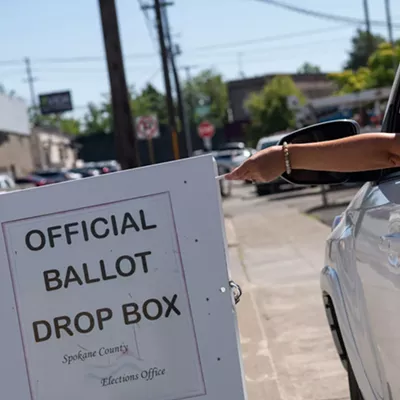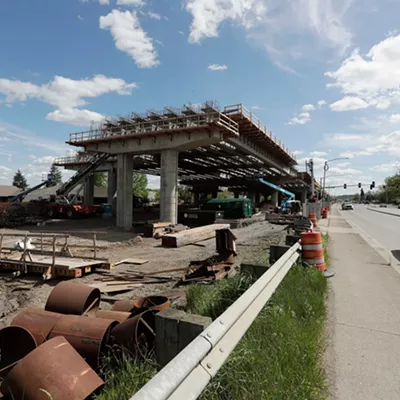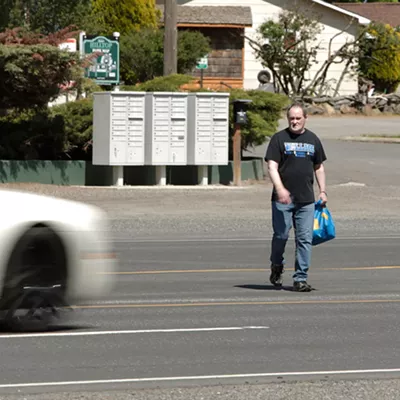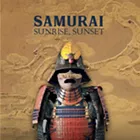It could have been Oct. 16, 1805, when curious Native Americans greeted Lewis and Clark's Corps of Discovery at the confluence of the Snake and Columbia rivers. But it isn't. Two hundred years to the day that the Corps of Discovery landed at what is now Sacajawea State Park in Pasco, Heritage Days celebrates this historic event at that very spot. Re-enactors from Eastern Washington's Company of Discovery play the parts of various members of the Corps of Discovery -- from those who paddle the 29-foot dugout canoes to Captain Meriwether Lewis himself.
"It's not at all practical," says Glen "Meriwether Lewis" Allison of his parade-dress uniform. "Then again, this was a military expedition."
Standing by a fire in front of his tent at last year's Heritage Days celebration, Allison looked dapper in his white, red and black uniform. But it's his oversized hat that makes the biggest impression. The chapeau bras is similar to one Napoleon wore -- a large, black semi-circle of a hat with a white stock of feathers like a duster at the top. And it certainly made an impression on the tribes Lewis and Clark encountered along their journey.
Reenactors dressed in their military best or buckskins display items utilized by the corps. Small axes, knives, fabric, thread and beads used for trading are spread out on a thick, striped, woolen blanket. Drills, gimlets, pliers and files, like those used daily by the corps, cover a rough-hewn, wooden table in front of a lean-to tent. Nearby, Gary Lentz, playing Sgt. Patrick Gass, fires a black-powder rifle, causing the small crowd gathered around him to jump.
But Heritage Days isn't just about the Corps of Discovery. After all, 200 Sahaptin-speaking Indians, whose village was on land near the meeting point of the Snake and Columbia rivers, welcomed the expedition members. Descendants of those Palouse, Walla Walla, Wanapum, Yakama and Umatilla Indians have set up their own encampments at the park for Heritage Days.
"This is a great opportunity for visitors and locals alike to learn about the two cultures that met at this place 200 years ago," says Kris Watkins, president of the Tri-Cities Visitor and Convention Bureau (VCB), which organizes the event.
Visitors to Heritage Days can walk through a long tule-mat lodge just like those Lewis and Clark saw along the Columbia River. The rhythmic, bass reverberations of Wanapum tribesmen chanting and drumming drifts across the lush park, as native dancers circle around the drummers. At a nearby table, a Umatilla tribeswoman helps children decorate cloth headbands with prints of local fish and feathers.
In a large, oval tipi, a Native American woman in traditional dress displays a cedar bag used for gathering berries. Nearby a tribe elder displays pelts, buckskin and rawhide which will be made into clothing. The buckskin has been tanned until it's as smooth as softened butter. Precious animal teeth and bear claws used to decorate native garments are spread out on a hand-woven cloth. At a booth outside the tipi, a woman from the Yakama tribe shows off a handmade, beaded saddle. Surprisingly, it's fabricated from wood and covered in deer hide, taking the better part of a year to make. In the next tent, dried sweet corn fills a hand-woven basket. A sample reveals a taste similar to modern Corn Nuts.
The fragrance of pear-cinnamon bread just out of a Dutch oven draws visitors to the mountain man encampment. Samples of more Dutch-oven cookery, such as apple cobbler or saut & eacute;ed potatoes and onions, are a savory contrast to what many mountain men subsisted on -- hard tack, jerky and black tea.
A member of the Tri-Cities Sagebrush Freetrappers displays a spork (a utensil with a spoon on one end and a fork at the other) used by mountain men who came to this area 10 years after the Corps of Discovery passed through. He then starts a fire with flint and steel, charcloth and rope tinder in a small fire pit encircled by stones. Another mountain man wearing a tall beaver hat moves two rusty leg-hold traps and a pile of pelts from the table before him to demonstrate how to set a beaver trap.
"People come to Heritage Days to have an experience where they can use their five senses to go back into this unique time in history," says Kathy Blasdell, a vice president for the Tri-Cities VCB. "They can smell the campfires burning, touch replica instruments corps members used and hear lively fiddle tunes."
It's a good thing that Heritage Days takes place from Friday through Monday, because there are more exhibits and presentations at a second location in Kennewick's Columbia Park. That's where the National Park Service's traveling exhibit, "Corps of Discovery II: 200 Years to the Future," will set up its cluster of two huge tents. The exhibit began its journey in January 2003 at Monticello, Thomas Jefferson's home in Virginia. Over the course of three years, the exhibit has made its way across 19 states as it traces the route followed by the explorers from beginning to end.
Interpretive exhibits housed in one tent bring to life the Corps of Discovery's journey across the West through visual and audio information about the expedition. In this walk-through exhibit, visitors can see what a corps soldier's uniform looked like, as well as find out what corps members did during their days and what they ate.
A Plains Indian tipi, dugout canoe and keelboat are also part of "Corps II," as the entire exhibit is known. At the tipi, visitors hear stories of what life was like for Indians on the Great Plains. They may see artifacts, such as a 19th-century water bottle, better known as a buffalo bladder. At the explorer campsite, a ranger sometimes cooks beaver tail, although not many people are brave enough to taste it. Visitors are usually surprised at the size and weight of the replica of a dugout cottonwood canoe used by the Corps of Discovery as they made their way up the Missouri and down the Columbia (and back again). A 33-foot-long keelboat (though not as large as the corps' keelboat, which was 55 feet long) gives visitors a glimpse of what life was like aboard the headquarters of the expedition 200 years ago.
Live performances and demonstrations take place at the 150-seat venue known as the Tent of Many Voices. Here visitors can experience living-history presentations, music, folklore, cultural demonstrations, readings from the expedition's journals, and video and slide presentations.
"The different stories told by American Indians, rangers, local historians and speakers at the Tent of Many Voices are a big draw," says Jeff Olson, NPS spokesman for Corps II. "Seeing descendants of members of the original expedition and the American Indians who helped them really resonates with visitors."
Olson says that the programs presented in the Tent of Many Voices are unique to each community because they draw upon the cultures and talents of individuals in the area. Local and national presenters tell their stories relating to the Lewis and Clark expedition in their own words. Traditional life ways are shared through demonstrations of arts, crafts and cultural life skills. Hourly presentations in the Tent of Many Voices include "Songs of the Journey," a musical and dramatic performance about the Lewis and Clark Expedition by the Edge of the Woods Players; Spokane actor David Casteal portraying Clark's black manservant in a critically acclaimed one-man play York, followed by a discussion by filmmaker Ron Craig; and Dr. Jim Chatters, the dynamic local anthropologist who studied the Kennewick Man remains, delving into the history of humans in North America.
"'Corps of Discovery II: 200 Years into the Future' continues to be a tremendous opportunity to learn more about our nation's history, including the history of the American Indian," says Gerard Baker, first superintendent of the Lewis and Clark National Historic Trail. "It's also a time to think about our nation's future and where we want to be 200 years from now."
Lewis & amp; Clark Heritage Days, "Down the Great Columbia," and "Corps of Discovery II" take place Friday-Monday, Oct. 14-17, from 9 am-5 pm at Sacajawea State Park, off Hwy. 12 in Pasco, Wash., and at Columbia Park at Hwys. 395 and 240 in Kennewick. Columbia River Journeys' jet boats and shuttle buses are available for transportation between the two parks Saturday and Sunday. Bicyclists can ride 6.5 miles along the Sacagawea Heritage Trail between the two locations. For more information, visit downthegreatcolumbia.com or call (800) 254-5824. Free.
















